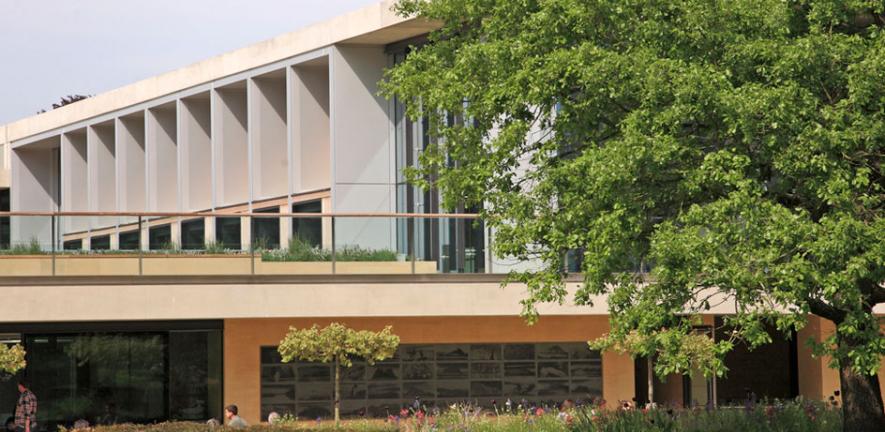
The Sainsbury Laboratory has been acclaimed as the World’s Best Learning Building 2011 at the World Architecture Festival in Barcelona.
The Sainsbury Laboratory has been acclaimed as the World’s Best Learning Building 2011 at the World Architecture Festival in Barcelona.
Designed by Stanton Williams architects, the 11,000 square metre plant science research centre set in the University’s Botanic Garden was selected by a panel of esteemed architects and designers, beating off competition from a shortlist of 17 entries.
From a British perspective these included Zaha Hadid’s Evelyn Grace Academy, winner of this year’s Stirling Prize, Norman Foster’s Masdar Institute in the United Arab Emirates and the City of Westminster College by Schmidt Hammer and Lessen.
Completed earlier this year and officially opened by Her Majesty The Queen in April, the Sainsbury Laboratory will eventually accommodate 120 world-leading scientists studying plant development and diversity in state-of-the art laboratory facilities.
The design reconciles complex scientific requirements with the need for a piece of architecture which responds to its landscape setting.
The jury commended the project, saying: “This project connects building and landscape in a poetic and meaningful way. It is beautifully considered in terms of its human scale, and for activities for research and learning. The choice of materials displays a profound tactile sense.”
Michael Bienias, Director of Estate Management for the University, said: “This marvellous and well-deserved award is testament to Stanton Williams’ design work, but also to the crucial and excellent collaborative work of the whole project team.”
The building was made possible with the award of an £82 million grant from the Gatsby Foundation. This is the largest single contribution received by the University since the launch of the 800th Anniversary Campaign.
Last month the Sainsbury Laboratory was highly commended in the Major Project category of the British Construction Industry Awards. It has been awarded a BREEAM “excellent” rating for its environmental performance.
Project Team
Client: The University of Cambridge
Funder: The Gatsby Charitable Foundation
Strategic Project Manager: Stuart A. Johnson Consulting Ltd
Project and Contract Administrator: Hannah Reed
Project Management: University of Cambridge Estate Management
Main Contractor: Kier Regional
Architect: Stanton Williams
Civil and Structural Engineer: Adams Kara Taylor
Building Services Engineer: Arup
Cost Consultant: Gardner & Theobald
Landscape Architects: Christopher Bradley-Hole Landscape and
Schoenaich Landscape Architects
BREEAM Assessor: Buro Happold Ltd
Key Dates
Construction Start date: February 2008
Completion Date: December 2010
Date of Occupation: January 2011
Project Duration: June 2006 – January 2011
Planning phase: June 2006 – February 2008
Construction phase: February 2008 - January 2011
Cambridge Plant Science Research Excellence
The University’s Department of Plant Sciences is the premier University centre for research in plant and microbial sciences. It offers unrivalled research and training opportunities in the following areas: Plant Development, Cell Biology, Photosynthesis and Metabolism, and Epidemiology, Ecology and Evolution.
The Department is led by Professor Sir David Baulcombe, the University’s Regius Professor of Botany. His research is being funded by a £2 million grant from the Gatsby Foundation, which has given a further £2 million to support additional research fellowships in the department. Professor Baulcombe was was awarded The Lasker Prize for his work, America’s highest research honour.
Gatsby Charitable Foundation
The Gatsby Charitable Foundation is an endowed grant-making trust founded by David Sainsbury. The Foundation has supported UK research in plant science continuously since the mid-1980s.
Stanton Williams Architects
Stanton Williams is a London-based firm of architects. The firm has developed its portfolio from an initial focus on museums and galleries towards a wide variety of projects, all of which demonstrate the practice’s over-arching objective of putting the user’s experience of space, light and materials at the forefront of the agenda.
The practice is responsible for the Wellcome Trust Millennium Building (WTMB), home to the Millennium Seed Bank Project and an integral part of the Wakehurst Place visitor experience in West Sussex, together with the Mansion and gardens. Stanton Williams has also been appointed to restore and develop the world-famous Botanic Gardens of the University of Padua.
Cambridge University Botanic Garden
The Cambridge University Botanic Garden holds a plant collection of over 8000 plant species from all over the world to facilitate teaching and research. The Garden provides resources including plant material, horticultural expertise and facilities to research workers and lecturers.
Since its foundation in 1846, however, the Botanic Garden has also provided a beautiful place for everybody to enjoy and benefit from - a series of wonderful landscapes through which to discover the drama of plant diversity.
This work is licensed under a Creative Commons Licence. If you use this content on your site please link back to this page.

